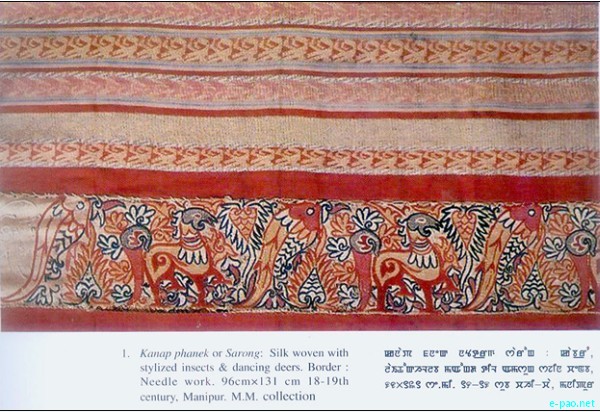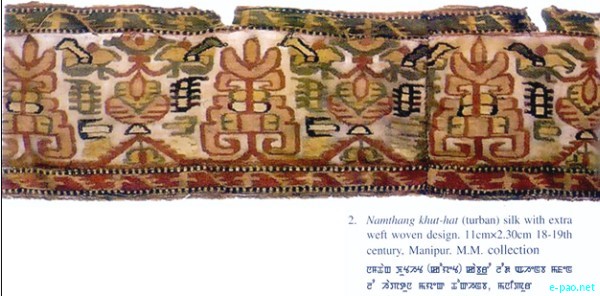Manipuri Textile from Bangladesh and Myanmar
- Art of Textile -
- Part 2-
By: Mutua Bahadur *
History
Those inhabitants of Manipur are known as Manipuris and they are also known as Meetei/Meitei. Manipur is one of North-Eastern states of India. The state lies south of Nagaland, east of Assam, west of Myanmar and north of Mizoram. Manipur has an area of 22,327 sq. km. Out of this, 20,089 sq. km lie in hilly areas while only 2,238 sq. km. is in the valley area. Manipuris (Meetei) densely populate the valley area. Meitei Pangals also settle around the valley area.
33 tribes recognized by the Indian Government settle in the hilly areas. Manipur was an independent - kingdom upto 1890-91, and had its own currency. In this state, royal administration was extended upto 1955. Manipur merged with the Indian Union in 1949. Since early times, Manipuri women practised weaving as one of their main occupations and produced enough cloths for domestic use. Those excess cloths were brought to market and sold. In this way, they supported their family economically.
Under royal patronage, there was a tradition of not mixing the profession of one clan with that of another clan. During Meidingu Loyumba's period (1074-1122), there was a tradition of weaving different textiles by 32 different clans. Besides, 7 different clans took the profession of vegetable dyeing for different colours. The tradition of vegetable dyeing was still flourishing before the 2nd World War.
If a Manipuri has a house, it should have a ningol ka (a room specially reserved for girls). The northern side of the manggol (verandah) is also reserved for weaving. Even a house not having girls has to keep a ningol ka. Friends of her locality will come with their tarengs (spinning wheel) and work inside the ningol ka. This tradition helped to develop the art of weaving and a self-sufficient society.
By a tradition, parents of a bride gave a weaving set for to their daughter as a part of her dowry. This tradition extended to a princess in a royal family. A few years back, there was a tradition of carrying tarengs (spinning wheels) on heads during marriage processions in Manipur and some parts of North-Eastern India settled by Manipuris.
From an early period, Manipuris has been practising the art ofproducing cloths from hill-grown cotton after a series of processes i.e. grinding of cotton by a kaptreng (seed separating machine), fluffing the cotton with a huitri (a bamboo bow), spinning, and then producing the cloth etc. Such a kind of art is vividly depicted by a maibi's dance during lai-haraoba (festival for pleasing the deities).
A group named 'Arts & Crafts' was established in 1927 by Maharani Dhanamanjuri and E.M. Joli after Manipur made an alliance with the British. In this way, the handloom products of Manipuri women extended their avenues. Handloom products like pillow covers, cushion covers etc. are exported to other parts

Fig 3
of India, and even to Europe, Australia and Africa etc. The handloom products of Manipur have attracted lots of attention not only in India but also abroad. Manipuris produced thread out of cotton balls. But they reared leima (silk worm) also, a mulberry worm, and silk was used to create lots of designs on clothes, and embroidered designs were done with needle. In Nupi Keithel (Women's market), a place is reserved for applique work only.
Mention is made of the use of different designs of loom-embroidery in some old manuscripts. At least not later than the 2nd century A.D., mulberry yarn was used in this slate. It was mentioned that products of mulberry were gifted to the East India Company during the reign of Gourashyam in 1763. A survey conducted by East India Company in 1882 found that mulberry trees were grown in plenty at various parts of the state. And it also found the eggs of mulberry worms in plenty in a natural way. Before the

Fig 4
Indian sub-continent had the knowledge of using mulberry yarn, the Manipuris knew earlier of the methods of weaving clothes out of mulberry. Various instances of history indicated that Manipuris settled at various parts of India, Bangladesh and Myanmar and became Bangladeshi Manipuris and Myanmarese- Manipuris. They developed their own life style there. There is proof to show that Manipuris settled at Khunmintanu of China before the Second World War.
Today, those Myanmarese Manipuris and Bangladeshi Manipuris who originated from Manipur, through many instances of history, have introduced their artistic textile products to the world. These women weavers have creative qualities in their blood inherited from their fore-fathers.
Chronological Table
| Year | Bangladesh |
| 1709-48 | Settled during the reign of Jaishree Garibaniwaj (Pamheiba), Maharaja, Manipur.Ava (Myanmar) invaded during the lime of Chinthangkhomba Maharaja. He fled to Cachhar and settled there while his followers settled at Sylhet at the same time. |
| 1819-1826 | Gambhir Singh Maharaja stayed at Sylhet during the Seven Years Devastation. After cleaning Mirja forest, he developed sang-gai-yumpham (royal palace), sanathong (royal gate), and three temples for Pakhangba, Yumjao Lairembi and Nongshaba, and dug a royal pond etc. |
| 1819-1826 | The Seven Years Devastation took place in Manipur after Myanmar conquered it. During that period, many Manipuris scattered and settled around various parts of Bangladesh and North-Eastern India. |
| 1840 | During Chandrakriti Maharaja's time (1850-1886), Maharaja Devendra and his followers settled at Dhaka. |
| Year | Myanmar |
| 1738 | Jaishree Garibaniwaj Maharaja marked the eastern door of the Kaunghmadaw Pagoda, situated at Sagaing, with his sword. |
| 1757 | King Alaungpaya brought some Manipuris from Manipur as captives and settled them at Sagaing and various parts of Amarapura district. He developed a Manipuri cavalry. |
| 1764 | Hasinbyushin invaded Manipur in December and took some Manipuris as captives to increase the Myanmarese population. 1775 'Achiek' highly prized Myanmarese National cloth, was introduced by the Manipuri women weavers near Patodasgyi Pagoda, which is situated near Amarapura. |
| 1780 | A Manipuri village named 'Kathe Khul' was developed at Mogok by Bodawpaya and they had to work in a ruby mine. |
| 1812 | Bodawpaya added another 45 Manipuri households to Mogok and they had to work in a ruby mine and the place became known as 'Haipi Kathe' (supplementary residents). There is more of Kate (Manipuri) villages near Kyatpayen due to increase in its population. |
| 1819-1826 | Ava (Myanmar) invaded Manipur and the Seven Years Devastation was there. They (Myanmarese) took Manipuri skilled labourers like weavers, carpenters, painters, goldsmiths, rowers, indigenous doctors, astrologers and purohits (priest) etc. to Myanmar as captives and settle them there according to their occupations. |
| 1820 | Bagyidaw brought about 30,000 Manipuris to Myanmar and had to settle them there after assuring them of secure jobs. |
| 1821 | Bagyidaw brought another 30,000 Manipuris to Myanmar and settled them there. |
See a gallery photo of this Textile here.
To be continued ....
|
* Mutua Bahadur contributes to e-pao.net regularly. This article was webcasted on August 27, 2010.
* Comments posted by users in this discussion thread and other parts of this site are opinions of the individuals posting them (whose user ID is displayed alongside) and not the views of e-pao.net. We strongly recommend that users exercise responsibility, sensitivity and caution over language while writing your opinions which will be seen and read by other users. Please read a complete Guideline on using comments on this website.









